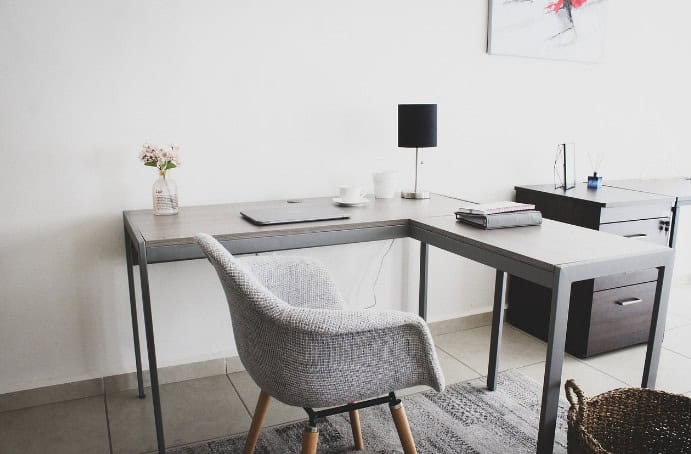Research shows that 35% of adults are now switching to home working in the US. Home working has become increasingly popular in the last five years.
Table of Contents
There are several advantages, including increased flexibility, but it can be difficult to switch from office work to being based at home. If you’re switching to home working any time soon, this guide will help you maximize productivity.

Switching To Home Working Tips:
Set up a dedicated workspace
The most important step to take when moving from an office to your home is to set up a dedicated workspace. Some people have a rose-tinted vision of home working, which involves people sitting in bed with a laptop balanced on their knees or tapping away on a keyboard in front of the TV.
In reality, it’s not possible to work efficiently and effectively without a proper workplace. You may be able to send an email first thing from the sofa, but you’ll need a quiet, comfortable space to work from home on a long-term basis.

If you don’t have an office at home, there are solutions. You can use a spare bedroom as a study by adding a desk and chair or switching the furniture to more versatile options, for example, replacing a bed with a daybed or a sofa bed.
You could also use the dining room as an office if you don’t usually use it during the day, or even section off part of the living space using a screen or curtain.
If you’re planning to work from home for a long time, it may be worth exploring options like adding a garden room, an orangery or a conservatory, or converting a loft or basement. This will help you create more usable space. These projects are not cheap, but they will add value. Look for ideas online and get some quotes before you decide what to do.

Make sure you have the equipment and tools you need
When you start working from home, you want to be able to transition seamlessly. To do this, it’s essential to make sure that you have all the equipment and tools you need. Think about what you use or have access to at the office.
Write a list and work your way through it before you start work. Speak to your employer or team leader to ensure that you have the devices or tools you need at home and discuss remote access.
If you use specific software or systems, make sure you’re up to speed with how to use them at home. You may need to buy devices or upgrade technology at home if your employer doesn’t supply everything you need.
For example, a printer. It’s a good idea to familiarize yourself with the setup before you turn on your laptop on your first Monday morning at home. Position everything where you want it on your desk and have a run-through.
Back pain is one of the most common complaints among people who have desk jobs. Studies show that up to 50% of office workers experience lower back pain. Maintaining good posture is crucial to increase productivity and reduce the risk of injuries.
Ensure that you have a comfortable, supportive office chair and a table or desk. If your chair isn’t adjustable, buy or rent an adjustable desk. You should be able to type without reaching for the keyboard.
Your spine should be straight and your shoulders relaxed. Ideally, the screen should be at eye level. Take regular breaks to stretch your body and rest your eyes.

Implement a routine
One of the key challenges of working from home is adjusting to a less stringent routine. When you work in an office, you sign in and log off at specific times, often completing structured tasks in between.
When you’re at home, you may find that it’s more difficult to establish a routine if your diary is more flexible. The best thing to do if you work better with a routine in place is to implement a new system.
Start work at the same time every morning and finish at the same time in the afternoon. Take breaks at regular intervals, schedule meetings and calls, and set aside time for independent activities.
Work around your core hours if your employer has a core hours policy. Play to your strengths. If you have to work between 10am and 4pm, for example, and you are a morning person, start the day at 8am and finish at 4pm. If you work better later in the day, begin at 10am and finish at 6pm.
Working from home has a reputation for being easier than going into an office, but many employees find that they work longer hours at home. If you find that you’re working more, and it’s impacting your work-life balance, get into the habit of sticking to your timetable.
Customize your home office to suit your needs and preferences
Customizing your home office can help you create a more productive and inspirational workspace. Think about the aesthetics and take elements from workplaces you’ve visited, using your personal experiences to design a space that works for you.
Perhaps you enjoyed having a large window next to your desk in your old office, or you miss having access to a coffee machine a few steps away. Maybe you like the funky modern aesthetic of a building you used to visit for meetings, or you wish you could break up the day with a game of pool like you used to.
Use ideas and inspiration to personalize your space. Look for a bean to cup coffee machine for your kitchen and a pool table for the living room. Position your desk to take advantage of natural light and spruce up the space using paint, wall art, plants and accessories.
Create an office that reflects your style and sets the tone for your work. If you have a creative role, you might want to design a fun, uplifting office, for example.

Avoid distractions
Our homes are not purpose-built for work and sometimes, it’s hard to focus due to distractions. You might be trying to contend with noise from the neighbors or your pets jumping up on the desk, for example.
It’s not always possible to avoid distractions, but there may be steps you can take to reduce noise and make it easier to concentrate. Buying noise-canceling headphones is a great idea.
It’s also wise to close doors or use screens to maintain privacy while you work. Try to avoid having your personal phone next to you and set times for other activities. This will help you concentrate during core working hours.
Establish clear rules to maintain a healthy work-life balance
One of the perks of working from home is that it’s easier to control your schedule. Many people find that being at home gives them a better work-life balance, but this is not always the case.
Some home workers work longer hours and the lines between work and downtime become blurred without set sign-in and clock-off times. If this sounds familiar, be proactive in establishing clear rules.

Make time for rest, exercise, hobbies and spending quality time with friends and family members. Set a cut-off point for making and receiving work-related calls and emails.
More and more people are working from home. There are numerous advantages such as escaping the commute, but it can be difficult to get used to being at home if you’re moving from an office. To maximize productivity, set up a dedicated workspace, customize your work area and take inspiration from previous workplaces.
Implement a routine that enables you to work efficiently and enjoy a healthy work-life balance and make sure you have everything you need before you begin. Set up your office, test out the workspace and make sure you are comfortable.



